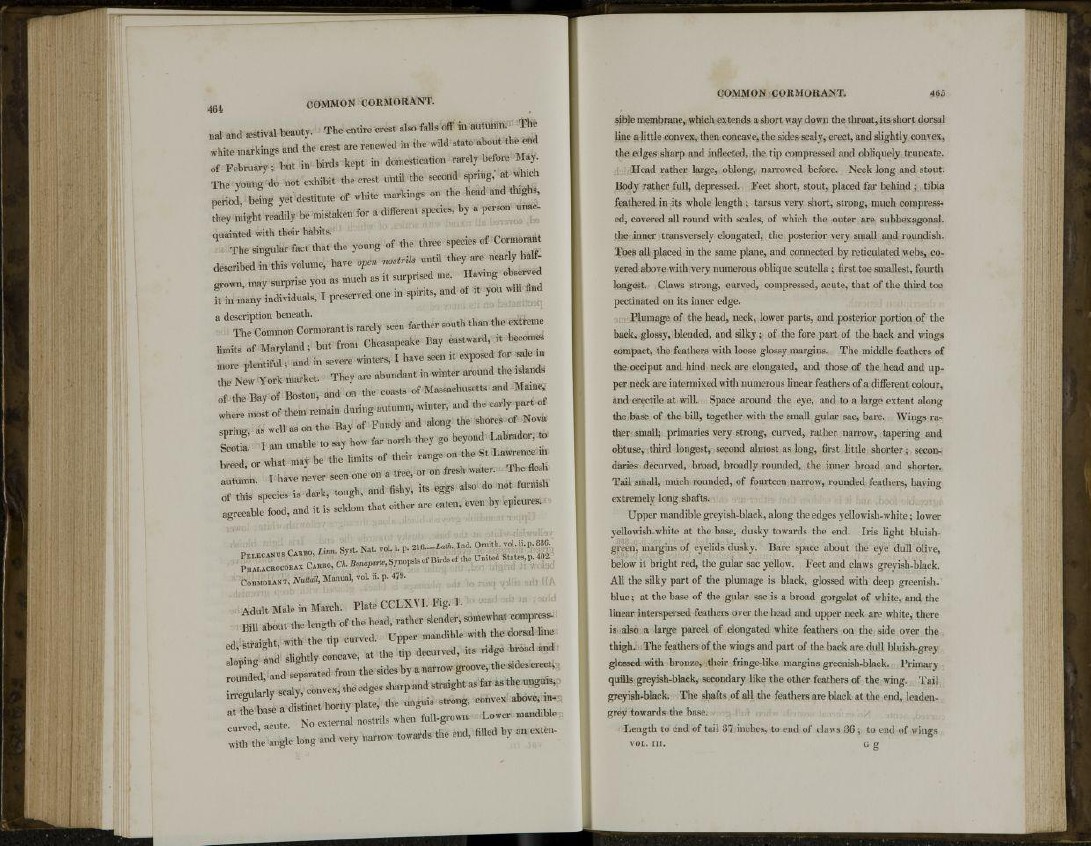
464
COMMON CORMORANT.
nal and aestival beauty. The entire crest also falls off in autumn. The
white markings and the crest are renewed in the wild state about the end
of February ; but in birds kept in domestication rarely before May.
The young do not exhibit the crest until the second spring,* at which
period, being yet destitute of white markings on the head and thighs,
they might readily be mistaken for a different species, by a person unacquainted
with their habits.
The singular fact that the young of the three species of Cormorant
described in this volume, have open nostrils until they are nearly halfgrown,
may surprise you as much as it surprised me. Having observed
it in many individuals, I preserved one in spirits, and of it you will find
a description beneath.
The Common Cormorant is rarely seen farther south than the extreme
limits of Maryland ; but from Cheasapeake Hay eastward, it becomes
more plentiful; and in severe winters, I have seen it exposed for sale in
the New York market. They are abundant in winter around the islands
of the Bay of Boston, and on the coasts of Massachusetts and Maine,
where most of them remain during autumn, winter, and the early part of
spring, as well as on the Bay of Fundy and along the shores of Nova
Scotia. I am unable to say how far north they go beyond Labrador, to
breed, or what may be the limits of their range on the St Lawrence in
autumn. I have never seen one on a tree, or on fresh water. The flesh
of this species is dark, tough, and fishy, its eggs also do not furnish
agreeable food, and it is seldom that either are eaten, even by epicures.
PELECANUS CAHBO, Linn. Syst. Nat. vol. i. p. 216.—Lath. Ind. Ornith. vol. ii.p. 886.
PHAI.ACROCORAX CARBO, Ch. Bonaparte, Synopsis of Birds of the United States, p. 402.
CORMORANT, Nuttall, Manual, vol. ii. p. 479.
XIIH orb If A
Adult Male in March. Plate CCLXVT. Fig. 1.
Bill about the length of the head, rather slender, somewhat compressed,
straight, with the tip curved. Upper mandible with the dorsal line
sloping and slightly concave, at the tip decurved, its ridge broad and
rounded, and separated from the sides by a narrow groove, the sides erect,
irregularly scaly, convex, the edges sharp and straight as far as the unguis,
at the base a distinct horny plate, the unguis strong, convex above, incurved,
acute. No external nostrils when full-grown. Lower mandible
with the angle long and very narrow towards the end, filled by an exten-
COMMON CORMORANT. 465
sible membrane, which extends a short way down the throat, its short dorsal
line a little convex, then concave, the sides scaly, erect, and slightly convex,
the edges sharp and inflected, the tip compressed and obliquely truncate.
Head rather large, oblong, narrowed before. Neck long and stout.
Body rather full, depressed. Feet short, stout, placed far behind ; tibia
feathered in its whole length ; tarsus very short, strong, much compressed,
covered all round with scales, of which the outer are subhexagonal.
the inner transversely elongated, the posterior very small and roundish.
Toes all placed in the same plane, and connected by reticulated webs, covered
above with very numerous oblique scutella ; first toe smallest, fourth
longest. Claws strong, curved, compressed, acute, that of the third toe
pectinated on its inner edge.
Plumage of the head, neck, lower parts, and posterior portion of the
back, glossy, blended, and silky; of the fore part of the back and wings
compact, the feathers with loose glossy margins. The middle feathers of
the occiput and hind neck are elongated, and those of the head and upper
neck are intermixed with numerous linear feathers of a different colour,
and erectile at will. Space around the eye, and to a large extent along
the base of the bill, together with the small gular sac, bare. Wings rather
small; primaries very strong, curved, rather narrow, tapering and
obtuse, third longest, second almost as long, first little shorter; secondaries
decurved, broad, broadly rounded, the inner broad and shorter.
Tail small, much rounded, of fourteen narrow, rounded feathers, having
extremely long shafts.
Upper mandible greyish-black, along the edges yellowish-white; lower
yellowish-white at the base, dusky towards the end. Iris light bluishgreen,
margins of eyelids dusky. Bare space about the eye dull olive,
below it bright red, the gular sac yellow. Feet and claws greyish-black.
All the silky part of the plumage is black, glossed with deep greenishblue
; at the base of the gular sac is a broad gorgelet of white, and the
linear interspersed feathers over the head and upper neck are white, there
is also a large parcel of elongated white feathers on the side over the
thigh. The feathers of the wings and part of the back are dull bluish-grey
glossed with bronze, their fringe-like margins greenish-black. Primary
quills greyish-black, secondary like the other feathers of the wing. Tail
greyish-black. The shafts of all the feathers are black at the end, leadengrey
towards the base.
Length to end of tail 37 inches, to end of claws 36 ; to end of wings
VOL. III. G g